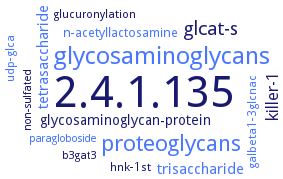Please wait a moment until all data is loaded. This message will disappear when all data is loaded.
Please wait a moment until the data is sorted. This message will disappear when the data is sorted.
V111M
-
mutation renders glycosaminoglycan biosynthesis temperature-sensitive, greater synthesis at 33°C compared with 37°C
C301A
-
mutant is not N-glycosylated, molecular weight is about 4000 Da less than that of the wild-type protein, enzyme is completely inactive
C33A
-
mutation abolishes the ability of the protein to form dimers
D113A
-
inactive mutant enzyme. Mutant enzyme is produced in a slightly lower amount compared with the wild-type enzyme
D113E
-
KM-value for UDP-glucuronate is 3.2fold higher than wild-type value
D113N
-
KM-value for UDP-glucuronate is 12.7fold higher than wild-type value
D194A
about 85% of wild-type activity
D194A/D195A
inactive mutant protein
D194A/D196A
inactive mutant protein
D194E
about 85% of wild-type activity
D195A
about 25% of wild-type activity
D195A/D196A
inactive mutant protein
D195E
about 30% of wild-type activity
D196A
about 30% of wild-type activity
D196E
about 25% of wild-type activity
G222A
activity towards Galbeta(1-3)Galbeta1-O-methoxyphenyl is reduced 3.7fold and activity towards Galbeta(1-3)Gal(6-sulfate)beta1-O-methoxyphenyl is reduced 7.1fold
G222A/G223A
nearly complete loss of activity towards Galbeta(1-3)Galbeta1-O-methoxyphenyl and Galbeta(1-3)Gal(6-sulfate)beta1-O-methoxyphenyl
G223a
nearly complete loss of activity towards Galbeta(1-3)Galbeta1-O-methoxyphenyl and Galbeta(1-3)Gal(6-sulfate)beta1-O-methoxyphenyl
H308A
mutation abrogates the activity towards UDP-GlcA
H308R
mutation induces a major change in specificity. In contrast to wild-type enzyme the mutant is able to efficiently transfer Glc from UDP-Glc onto acceptor substrate Galbeta(1-3)Gal. The mutant enzyme remains able to catalyze the transfer of GlcA from UDP-GlyA onto Galbeta(1-3)Gal. UDP-GlcNAc is used at about the same rate as UDP-Glc. UDP-Gal is a weak donor substrate. UDP-Man is efficiently used as cosubstrate. No activity with GDP-Man
H308R/R277A
mutant enzyme shows no activity with UDP-GlcA as donor substrate, mutant enzyme is active with UDP-Gly as donor
K317A
complete loss of activity towards Galbeta(1-3)Galbeta1-O-methoxyphenyl and Galbeta(1-3)Gal(6-sulfate)beta1-O-methoxyphenyl
K317R
activity towards Galbeta(1-3)Galbeta1-O-methoxyphenyl is reduced 7.2fold and activity towards Galbeta(1-3)Gal(6-sulfate)beta1-O-methoxyphenyl is reduced 6.5fold
Q318A
activity towards Galbeta(1-3)Galbeta1-O-methoxyphenyl is reduced 1.4fold and activity towards Galbeta(1-3)Gal(6-sulfate)beta1-O-methoxyphenyl is nearly identical to wild-type enzyme
R156A
-
inactive mutant enzyme
R156K
-
inactive mutant enzyme
R161A
-
inactive mutant enzyme
R161K
-
KM-value for UDP-glucuronate is 21.2fold higher than wild-type value
R310A
-
KM-value for UDP-glucuronate is 3.5fold higher than wild-type value
R310K
-
KM-value for UDP-glucuronate is identical to wild-type value
R310Q
-
KM-value for UDP-glucuronate is 1.5fold lower than wild-type value
W243A
inactive mutant protein
W243F
activity towards Galbeta(1-3)Galbeta1-O-methoxyphenyl is reduced 12fold and activity towards Galbeta(1-3)Gal(6-sulfate)beta1-O-methoxyphenyl is reduced 29fold
Y84A
-
inactive mutant enzyme, slightly less expressed than wild-type enzyme
Y84F
-
mutant enzyme shows 60% of wild-type activity. Mutant enzyme is produced at higher level than the wild-type protein. KM-value for UDP-glucuronate is 3fold higher than wild-type value
Y84H
-
mutant retains 21% of the activity with a KM value double that of the wild type. KM-value for UDP-glucuronate is 2.3fold higher than wild-type value
additional information
creation of dGlcAT-P null mutants, mutant larvae show lower expression of glucuronylated T antigen on the muscles and at NMJs. Mislocalization of neuromuscular junction (NMJ) boutons and a partial loss of the basement membrane components collagen IV (Col IV) and nidogen (Ndg) at the muscle 6/7 boundary are observed. Those two phenotypes are correlated and identical to previously described phenotypes in dC1GalT1 mutant larvae. In addition, dGlcAT-P null mutants exhibit fewer NMJ branches on muscles 6/7. Ultrastructural analysis reveals that basement membranes that lacks Col IV and Ndg are significantly deformed. The loss of dGlcAT-P expression causes ultrastructural defects in NMJ boutons




 results (
results ( results (
results ( top
top






